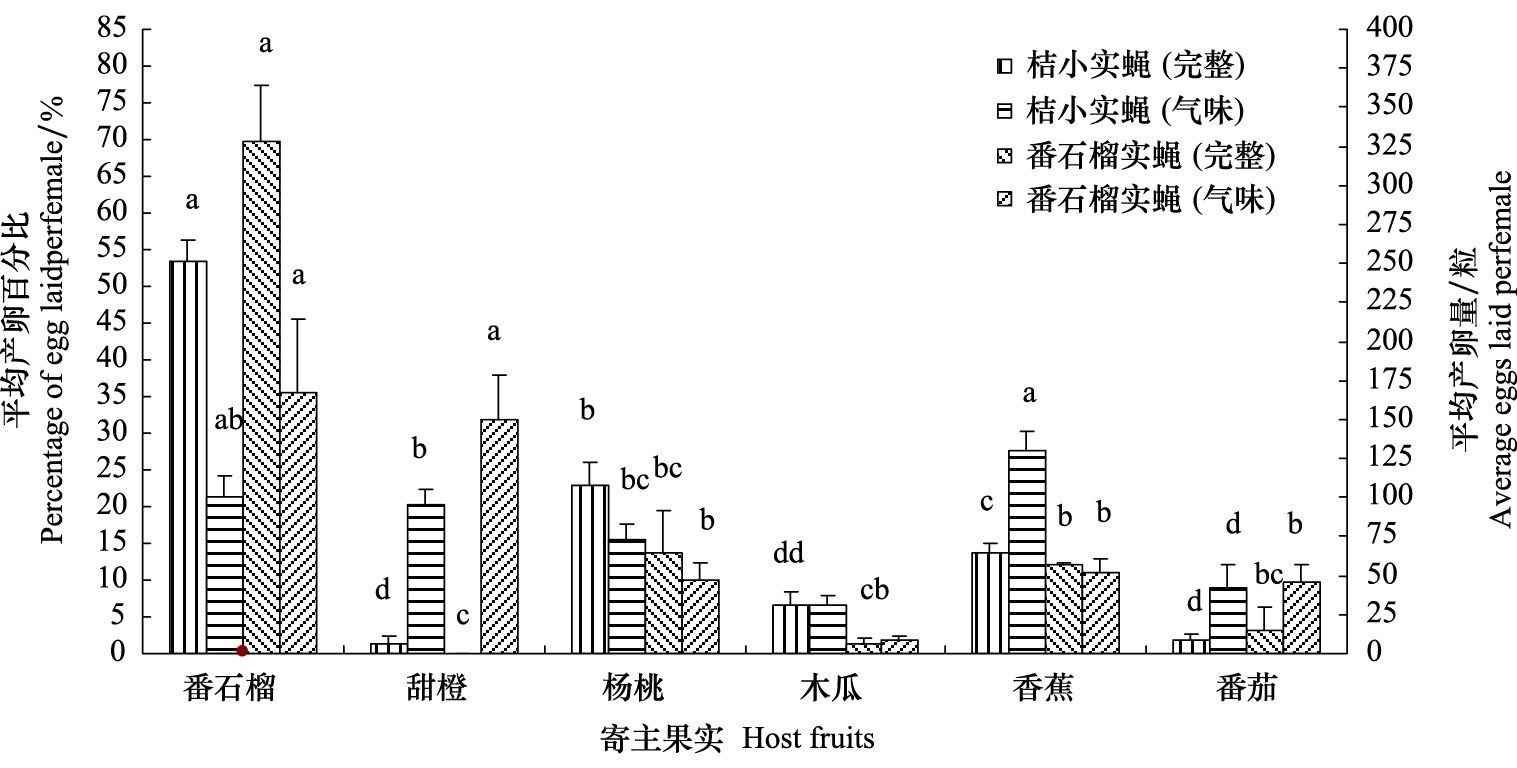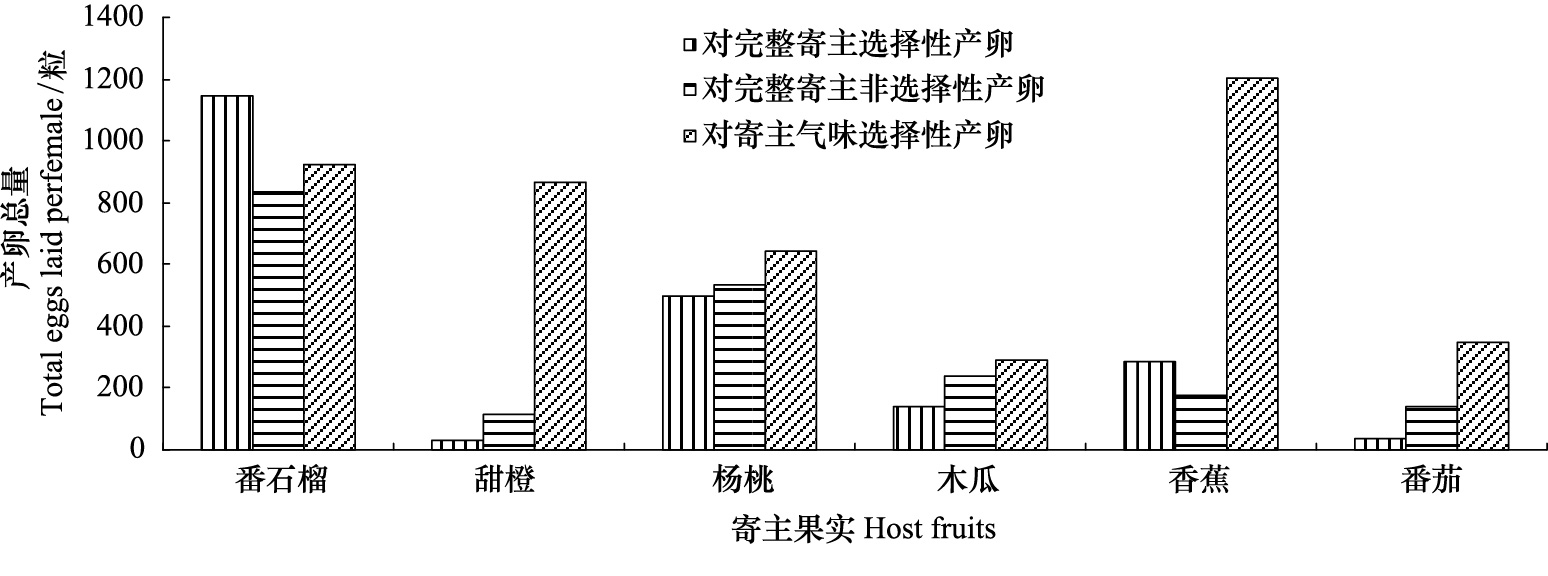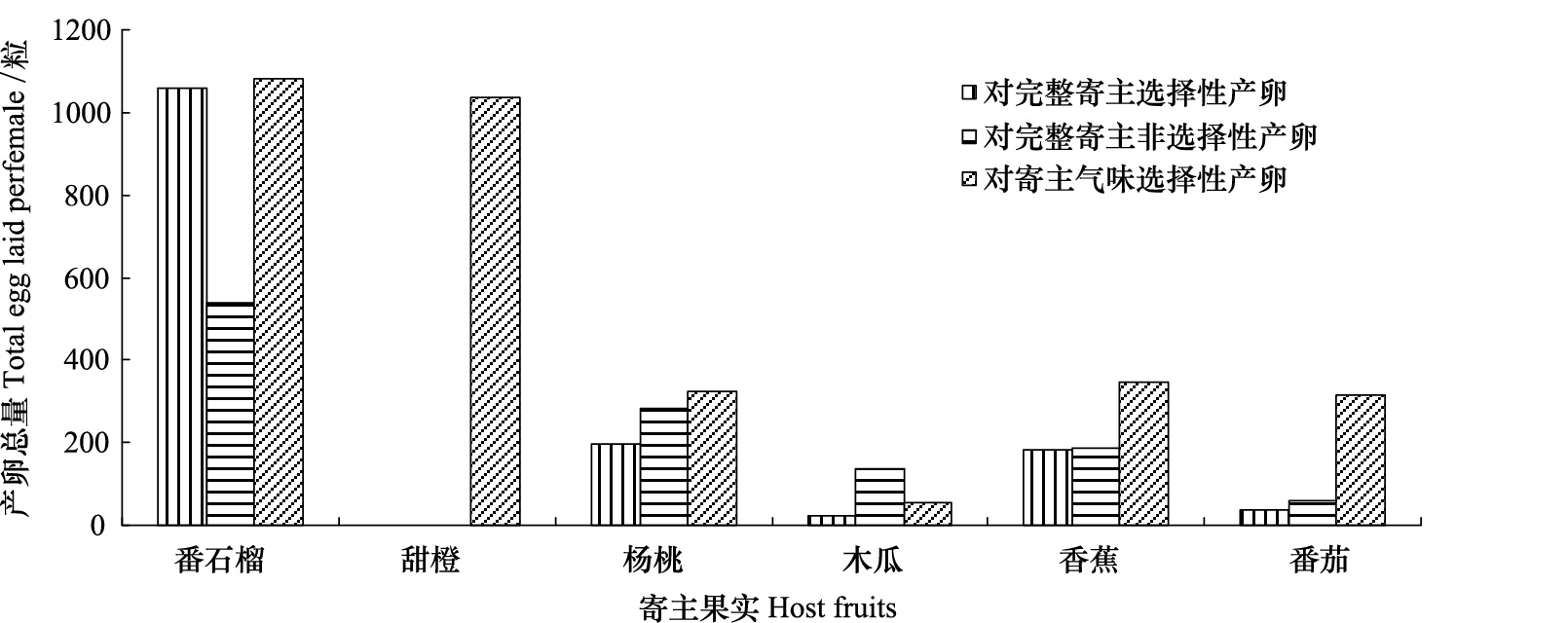文章信息
- 刘慧, 侯柏华, 张灿, 何日荣, 梁帆, 郭明昉, 武目涛, 赵菊鹏, 马骏
- LIU Hui, HOU Bohua, ZHANG Can, HE Rirong, LIANG Fan, GUO Mingfang, WU Mutao, ZHAO Jupeng, MA Jun
- 桔小实蝇和番石榴实蝇对6种寄主果实的产卵选择适应性
- Oviposition preference and offspring performance of the oriental fruit fly Bactrocera dorsalis and guava fruit fly B.correcta (Diptera: Tephritidae) on six host fruits
- 生态学报, 2014, 34(9): 2274-2281
- Acta Ecologica Sinica, 2014, 34(9): 2274-2281
- http://dx.doi.org/10.5846/stxb201306101613
-
文章历史
- 收稿日期:2013/6/10--
- 修订日期:2014/2/13--
2. 广东出入境检验检疫局检验检疫技术中心, 广州 510623;
3. 湖南农业大学植物保护学院, 长沙 410128
2. Guangdong Inspection and Quarantine Technology Center, Guangzhou 510623, China;
3. College of plant protection, Hunan Agricultural University, Changsha 410128, China
实蝇属于双翅目(Diptera),实蝇科(Tephritidae),是一类广泛分布于热带和亚热带的昆虫。全世界实蝇种类约有4000多种,其中具有经济危害性的害虫种类主要由具有地理分布差异的5个类群组成,分别为按实蝇属(Anastrepha)、离腹寡毛实蝇(Bactrocera)、合腹寡毛实蝇(Dacus)、腊实蝇属(Ceratitis)和绕实蝇属(Rhagoletis)。实蝇的成虫产卵于寄主果实,卵孵化后在果实中取食为害,造成落果或使果实失去食用价值,严重影响果蔬产品的国际贸易[1]。
由于实蝇以幼虫在寄主水果中取食危害,因此易于随寄主水果人为携带作远距离传播,由此造成实蝇的入侵和扩散。在我国南方具有经济重要性实蝇类群中,桔小实蝇Bactrocera dorsalis (Hendel )作为一种外来入侵实蝇已广泛分布于华南地区,该实蝇取食的寄主种类多、生态适应性强,以成为华南地区实蝇类群的优势种[2]。番石榴实蝇B.correcta (Bezzi )是近年来传入我国并定殖于云南的另一种外来实蝇[3]。两种实蝇作为分类上同属的近缘种类,其生物学和生态学特征具有较强的相似性。现实的问题是对于具有相似生态位的两种实蝇一旦相遇,如何评价两者对寄主资源利用的分化和重叠程度?两种实蝇对寄主果实的选择各自有何适应性特征?对这些问题的解答不但有助于揭示实蝇对寄主植物的选择适应性,而且有助于预测实蝇种间的竞争作用。
植食性昆虫寄主选择行为是昆虫行为生态研究的重要内容[4]。昆虫对寄主植物的产卵选择实际上包括对寄主的产卵选择和后代生长发育两方面的综合过程[5]。影响植食性昆虫产卵选择的因素包括:寄主植物的种类、同一种类寄主的不同品种、寄主的成熟度、寄主的不同部位以及寄主的颜色和形状等[6, 7, 8, 9, 10]。而作为昆虫食物来源的寄主本身,其体内所含有的营养物质和次生化合物[11],通过昆虫取食可直接或间接影响昆虫的生长发育、存活以及繁殖乃至整个种群的生长动态[12]。本论文以桔小实蝇和番石榴两种实蝇为研究对象,测定两者在番石榴Psidium guajava、香蕉Musa paradisiaca、杨桃Averrhoa carambola、木瓜Carica papaya、甜橙Citrus sinensis和番茄Solanum lycopersicum 共6种寄主果实上的产卵选择性以及在这6种寄主果实上幼虫的生长发育情况,分析两种实蝇对寄主果实的产卵选择性与以及后代生长发育指标之间的相关性,并进一步探讨这两种实蝇对寄主的选择适应性特征。
1 材料与方法 1.1 试验材料(1)供试昆虫 桔小实蝇采自广州花都区的番石榴果园,番石榴实蝇采自云南元江县的番石榴果园,均在室内用人工饲料饲养5代以上。幼虫人工饲料参考焦懿等[13]的方法配制;成虫饲料配方为酵母 ∶ 糖=1 ∶ 3。实验室饲养条件为光暗周期(L ∶ D)= 14 h ∶ 10 h、温度(25±1)℃、相对湿度65%左右。
(2)供试寄主 选用广州常见的并且具有经济重要性的6种实蝇寄主果实,分别为番石榴(品种为台湾水晶番石榴);香蕉(品种为香牙蕉);杨桃(品种为粤好5号);木瓜(品种为穗中红48);甜橙(品种为柳橙);番茄(品种为英石大红)。选择大小和成熟度一致、无农药污染的套袋完整果实作为供试寄主。
1.2 实验方法以下各实验桔小实蝇和番石榴实蝇各实验均均是独立进行开展的,实验条件与上述供试昆虫饲养条件相同。成虫饲养所用的虫笼大小为长×宽×高=70 cm × 55 cm × 50 cm。
1.2.1 产卵选择性实验(1)对完整寄主果实的直接选择性产卵
在每个虫笼内接入30对产卵盛期的实蝇成虫,并将6种供试寄主果实各取1个放入笼内,呈直线随机排列,让成虫直接产卵。每个果实之间相隔约10 cm,参照前人实验设计[14],在实蝇日产卵高峰期让其产卵6 h,时间段为10:00—16:00。产卵结束后将寄主果实分别放在塑料保鲜盒内,待12 d后清洗果实检查统计幼虫数。各处理重复3次。
(2)对完整寄主果实的非选择性产卵
选用上述6种寄主果实,每个虫笼内接入15对实蝇,将同种寄主3个放入笼内,直线排列,间隔约20 cm。具体产卵时间设定和统计方法同1.2.1.1。
(3)由寄主气味诱导的选择性产卵
在每个虫笼接入30对实蝇后,将上述6种寄主果实切成大小为20 g/块的长方形方块,每块放入一个自制圆柱状的塑料采卵器(r=2.5 cm,h=12 cm)内,具体排列方法和产卵时间设定同(1)。达到设定的产卵时间后收集每个采卵器中的卵量。各处理重复3次。
1.2.2 两种实蝇取食寄主果实的生长发育适应性采用湿润滤纸,将孵化3 h内的实蝇幼虫按照50头幼虫/100 g果实的接虫量,接入上述6种寄主中[15]。接完虫的果实放在带有网状盒盖的塑料保鲜盒(r=8 cm,h=9 cm)内;接虫后第6天在塑料盒底部铺一层湿润的沙;每天将沙过筛收集蛹;每头蛹单独称重,然后放入带湿润沙的96孔细胞培养板内直到成虫羽化。记录幼虫和蛹的成活率和历期、蛹重以及羽化后成虫的性别等参数。各处理重复3次。
1.3 数据分析观测数据采用统计分析软件SPSS 13.0进行单因素方差分析,应用Duncan新复极差法进行多重比较。
2 结果与分析 2.1 两种实蝇的产卵选择性 2.1.1 对完整寄主果实的直接产卵选择性结果表明,6种供试寄主果实无论是完整寄主果实还是块状寄主果实气味的诱导,两种实蝇都倾向于选择番石榴产卵,尤其是对完整寄主果实,桔小实蝇和番石榴实蝇在番石榴中的产卵百分率分别为53.31%和69.68%,均显著高于在其它寄主果实(图 1)。两种实蝇在两种产卵选择处理中对甜橙产卵选择性差异均较大,在完整寄主果实处理中,在甜橙中的着卵量极少甚至没有;但在寄主果实气味诱导产卵的处理中,由甜橙果实气味诱导的产卵率与番石榴果实气味诱导的产卵率两者没有显著差异,且产卵率均较高。比较而言,木瓜和番茄均是两种实蝇不嗜好选择产卵的寄主,但对其它供试果实之间,桔小实蝇对杨桃和香蕉的产卵选择性高于番石榴实蝇,同时发现,两种实蝇对番石榴和杨桃完整寄主果实的选择产卵率均高于由相应寄主果实气味诱导的产卵率,但是,该情形与它们对甜橙和番茄的产卵选择性恰恰相反(图 1)。总之,无论是桔小实蝇还是番石榴实蝇,对于同种寄主果实,由于供试寄主的产卵选择方式不同可导致两种实蝇的选择性产卵率具有显著差异。

|
| 图 1 桔小实蝇和番石榴实蝇6种完整寄主果实及寄主气味的选择性产卵 图上的英文字母表示同种实蝇同种寄主形式下在6种寄主果实上的选择差异性(P<0.05); 桔小实蝇 Bactrocera dorsalis; 番石榴实蝇 B.correcta Fig. 1 The selective oviposition of Bactrocera dorsalis and B.correcta on six host fruits provided by intact fruit or fruit odor-lured with artificial egg collector |
两种实蝇在选择和非选择性实验中对每种寄主果实的3个重复的产卵总量如图 2和图 3所示。表明在两种完整寄主果实的选择和非选择性实验中,两种实蝇对6种寄主果实产卵总量的变化趋势均非常一致;而两种实蝇对寄主果实气味诱导产卵总量则与完整果实的明显不同,尤其是对甜橙和香蕉两种寄主,两种实蝇分别对同一种寄主不同处理的产卵差异性达到极显著,表现为对寄主果实气味诱导产卵量比对完整寄主果实的明显增多,番石榴实蝇对甜橙的完整果实几乎不能有效产卵。

|
| 图 2 桔小实蝇在不同处理下对每种寄主果实产卵总量 Fig. 2 The total eggs laid by Bactrocera dorsalis on six host fruits under different treatments |

|
| 图 3 番石榴实蝇在不同处理下对6种寄主的产卵量 Fig. 3 The total eggs laid by B.correcta on six host fruits under different treatments |
两种实蝇在6种寄主果实上的生长发育适应性以幼虫历期、化蛹率、蛹历期、蛹重和羽化率作为评价指标。结果表明,6种寄主果实对两种实蝇的生长发育适应性各指标的影响差异显著(表 1—表 3)。
| 性别 Gender | 寄主果实 Host fruits | 幼虫历期/d Duration of larval stage M ± SD(样本数Sample size) | 蛹历期/d Pupal duration M ± SD(样本数Sample size) | 蛹重/g Pupal weight M ± SD(样本数Sample size) |
| 同列中同一性别数据后字母不同表示差异显著(P<0.05) | ||||
| ♀ | 番石榴Guava | 9.02 ± 0.15(58)b | 13.67 ± 0.07(58)c | 0.0140 ± 0.0002(58)d |
| 甜橙Orange | 11.98 ± 0.24(48)a | 14.83 ± 0.10(48)a | 0.0174 ± 0.0002(48)b | |
| 杨桃Carambola | 11.34 ± 0.38(41)a | 14.10 ± 0.12(41)b | 0.0164 ± 0.0002(41)c | |
| 木瓜Pawpaw | 7.72 ± 0.27(43)c | 14.81 ± 0.10(43)a | 0.0142 ± 0.0002(43)d | |
| 香蕉Banana | 11.82 ± 0.33(51)a | 15.04 ± 0.12(51)a | 0.0177 ± 0.0003(51)ab | |
| 番茄Tomato | 7.13 ± 0.15(32)c | 14.75 ± 0.09(32)a | 0.0183 ± 0.0002(32)a | |
| ♂ | 番石榴Guava | 9.20 ± 0.16(61)b | 13.57 ± 0.07(61)d | 0.0134 ± 0.0002(61)c |
| 甜橙Orange | 12.00 ± 0.18(58)a | 14.76 ± 0.08(58)b | 0.0168 ± 0.0002(58)a | |
| 杨桃Carambola | 11.42 ± 0.35(48)a | 14.21 ± 0.10(48)c | 0.0155 ± 0.0002(48)b | |
| 木瓜Pawpaw | 7.85 ± 0.27(46)c | 14.94 ± 0.10(46)ab | 0.0133 ± 0.0002(46)c | |
| 香蕉Banana | 11.65 ± 0.33(57)a | 15.00 ± 0.10(57)a | 0.0169 ± 0.0002(57)a | |
| 番茄Tomato | 7.03 ± 0.13(38)c | 14.82 ± 0.07(38)ab | 0.0174 ± 0.0002(38)a | |
| 性别 Gender | 寄主果实 Host fruits | 幼虫历期/d Duration of larval stage M ± SD(样本数Sample size) | 蛹历期/d Pupal duration M ± SD(样本数Sample size) | 蛹重/g Pupal weight M ± SD(样本数Sample size) |
| 同列中同一性别数据后字母不同表示差异显著(P<0.05) | ||||
| ♀ | 番石榴Guava | 9.47 ± 0.12(58)a | 12.21 ± 0.06(58)d | 0.0114 ± 0.0002(58)d |
| 甜橙Orange | 8.80 ± 0.20(55)ab | 12.60 ± 0.08(55)abc | 0.0134 ± 0.0002(55)b | |
| 杨桃Carambola | 9.08 ± 0.1870(50)a | 12.86 ± 0.08(50)a | 0.0134 ± 0.0002(50)b | |
| 木瓜Pawpaw | 6.64 ± 0.09(53)c | 12.34 ± 0.10(53)cd | 0.0125 ± 0.0002(53)c | |
| 香蕉Banana | 9.56±0.20(39)a | 12.44±0.10(39)bcd | 0.0131 ± 0.0003(39)bc | |
| 番茄Tomato | 8.25 ± 0.17(32)b | 12.81 ± 0.10(32)ab | 0.0143 ± 0.0002(32)a | |
| ♂ | 番石榴Guava | 9.70 ± 0.11(59)a | 12.17 ± 0.05(59)b | 0.0104 ± 0.0001(59)c |
| 甜橙Orange | 8.59 ± 0.19(63)bc | 12.75 ± 0.08(63)a | 0.0125 ± 0.0002(63)ab | |
| 杨桃Carambola | 9.20 ± 0.21(51)ab | 12.96 ± 0.09(51)a | 0.0121 ± 0.0002(51)b | |
| 木瓜Pawpaw | 6.66 ± 0.07(65)d | 12.29 ± 0.08(65)b | 0.0118 ± 0.0001(65)b | |
| 香蕉Banana | 9.32 ± 0.19(44)ab | 12.71 ± 0.08(44)a | 0.0126 ± 0.0003(44)ab | |
| 番茄Tomato | 8.30±0.1519(50)c | 12.88±0.0545(50)a | 0.0133±0.0002(50)a | |
| 寄主果实Host fruits | 桔小实蝇Bactrocera dorsalis | 番石榴实蝇B.correcta | ||
| 化蛹率/% Percentage of pupation (M ± SD) | 羽化率/% Eclosion rate (M ± SD) | 化蛹率/% Percentage of pupation (M ± SD) | 羽化率/% Eclosion rate (M ± SD) | |
| 同列数据后字母不同表示差异显著(P<0.05) | ||||
| 番石榴Guava | 87.33±4.06 a | 90.80±0.43 a | 83.33±0.67 ab | 93.57±2.16 a |
| 甜橙Orange | 78.67±2.40 abc | 89.81±0.32 a | 86.00±5.29 ab | 91.36±2.33 a |
| 杨桃Carambola | 70.67±3.71 bc | 83.78±1.71 ab | 78.67±2.91 bc | 85.25±6.75 ab |
| 木瓜Pawpaw | 68.67±4.67 c | 86.41±0.35 b | 91.33±2.91 a | 85.92±3.93 ab |
| 香蕉Banana | 81.33±6.57 ab | 88.48±0.66 ab | 70.67±4.06 cd | 78.63±2.99 b |
| 番茄Tomato | 52.67±0.67 d | 86.04±1.42 ab | 66.00±2.00 d | 82.56±4.79 b |
(1)幼虫发育历期 桔小实蝇以取食木瓜和番茄的历期为最短,分别7.7 d和7.1 d,番石榴实蝇也 以取食木瓜的历期为最短(6.6 d);桔小实蝇和番石榴实蝇幼虫发育历期最长的寄主果实分别为甜橙(12.0 d)和番石榴(9.7 d)。
(2)蛹历期 两种实蝇蛹的历期在6种寄主果实饲养下差异相对较小,桔小实蝇蛹的发育历期在13.6 d—15.4 d之间,番石榴实蝇在12.2 d—13.0 d之间。
(3)蛹重 桔小实蝇和番石榴实蝇两种实蝇均以番茄饲养的蛹最重,分别为18.3 mg和14.3 mg,而在番石榴上饲养出的蛹最轻,分别为14.0 mg和11.4 mg。
(4)化蛹率 桔小实蝇在番石榴上饲养的化蛹率为最高(87.3%),而在番茄饲养的为最低(52.7%);番石榴实蝇以木瓜上的最高,达到91.3%,而在番茄上为最低,为66.0%。
(5)羽化率 桔小实蝇在6种寄主果实上的羽化率均较高,平均在85%以上;番石榴实蝇以番石榴和甜橙饲养的羽化率较高,分别为93.6%和91.4%,以香蕉饲养的羽化率较低为78.6%。另外,在任一种寄主果实上,每种实蝇的雌虫和雄虫的发育历期均无显著性差异,但雌虫蛹重均显著高于雄虫(P<0.05)。
3 结论与讨论 3.1 寄主物理特征对实蝇寄主产卵选择性的影响无论桔小实蝇还是番石榴实蝇在两种产卵选择性实验中,对寄主果实-甜橙的不同供试方式其产卵选择性差异均较大,表现为以寄主果实气味诱导的人工采卵量明显大于直接以完整寄主果实供试的采卵量,表明寄主果实本身的理化特征是影响实蝇产卵选择的重要因素。昆虫的感受识别是寻找寄主的第一步,寄主挥发性物质对植食性昆虫搜索寄主的行为起重要作用[1, 14]。两种实蝇对6种供试寄主果实的产卵选择性具有明显的差异,该差异性不但受寄主气味的诱导,而且受寄主果实表皮物理特性的影响。寄主的物理特征包括寄主表皮韧性、茸毛以及颜色、形状、大小等因素[16, 17],影响的大小由实蝇本身的喜好和接受能力等决定,即使是植物微小形态的改变也会影响昆虫的适合度[18]。由于甜橙的果皮较厚且硬度较大,所以在完整寄主果实的实验中,可能由于其果皮的硬度阻碍了实蝇产卵的成功性。在产卵过程中观察发现,许多实蝇在甜橙、香蕉和番茄上具有产卵行为,但可能由于其果皮坚硬、较厚或者较光滑,导致实蝇不选择产卵或很少有卵粒产入果实中,即使有卵粒只留在果实表层,也不能正常孵化存活,成为无效产卵。
此外,除寄主果实理化性状外,实蝇自身生理条件也是影响产卵选择重要因素,尤其是它们的取食经历和记忆行为[19, 20]。桔小实蝇幼虫期取食的水果种类对其后代的寄主产卵选择性影响较大[9, 21]。因此,分析实蝇对寄主的喜好性除了考虑寄主果实本身各种因素的影响外,还要考虑实蝇本身生理条件的影响。
3.2 有关实蝇寄主适合度评价本研究发现,不同寄主果实中饲养出的每一种实蝇的5种生长发育参数具显著差异性。表明寄主植物的营养成份和次生化合物除影响昆虫产卵选择性以外,还影响昆虫的生长发育和繁殖[22]。桔小实蝇在嗜好品种上产卵最多,存活率也高[23]。结合块状寄主果实气味诱导产卵选择性实验,发现桔小实蝇较喜欢选择番石榴、甜橙和香蕉。从成活率角度看,上述3种寄主饲养的桔小实蝇无论化蛹率还是羽化率相对其它寄主果实均高;番石榴实蝇倾向于选择番石榴和甜橙,也显示了相同趋势。然而,番石榴实蝇在不太喜欢的木瓜上的成活率也较高。有人用蛹重量作为衡量实蝇幼虫成功发育的因素[24],认为较大的蛹羽化的昆虫更有利于其后期发展。但是,本研究发现,番石榴虽是两种实蝇均比较喜欢的寄主,但从番石榴上饲养出的蛹重却明显偏低;而番茄是两种实蝇都不太喜欢选择的寄主,但在番茄上饲养出的蛹却最重。也有人通过发育历期评价寄主适应性,认为发育历期短的寄主适合实蝇,果实中先孵化出来的幼虫将取得优势[25]。然而,本研究结果显示,番石榴虽然是番石榴实蝇比较喜欢的寄主,但发育历期相对却较长;木瓜和番茄均是两种实蝇不太喜欢选择的寄主,但在木瓜和番茄上饲养的实蝇发育历期却较短。也有研究发现,木瓜实蝇对番茄几乎不选择产卵,但是在番茄上饲养出的木瓜实蝇发育历期相对其它喜嗜寄主较短、蛹也较重[26]。
总之,若仅采用单项指标评价实蝇对寄主的选择适应性,有时会得到自相矛盾的结论。本文通过多个生长指标综合分析,发现以气味诱导喜嗜产卵的寄主果实总体上更加适宜两种实蝇的生长发育,但某些非嗜好产卵的寄主果实却有利于实蝇的生长发育这一现象值得进一步研究。当然,在两种实蝇后代取食适应性测定实验中,有必要事先明确两种实蝇幼虫分别在不同寄主果实上的饱和密度,从而确定每种实蝇对每种寄主果实的利用率;通过实验获得每种实蝇在每种寄主果实上最佳密度时每个发育阶段的各个生长指标,以保证测定结果的可靠性。
关于植食性昆虫对其寄主植物的产卵选择适合度问题备受关注[27]。在相关研究中,出现了“选择性与适合度”假说(Oviposition-preference-offspring-performance hypothesis)[28],后简化为(Preference-performance hypothesis,PPH)[29]。该假说认为,昆虫幼虫期不适宜远距离移动,所以雌成虫应该最大限度的把卵产在适合幼虫发育的寄主上。很多人在他们的研究中证实了昆虫产卵的选择性与后代的良好发育具有很好的正相关,支持了该假说[22, 30];然而,也有一些研究发现,昆虫产卵的选择性与后代发育的适合度没有一定的相关性[31],或者和本文研究结果一样,在一定的研究条件下,无法发现选择性和适应性之间的明显规律[26, 32]。有人提出,通过计算其羽化的雌虫数和羽化后雌虫的生殖力可能是反映寄主适合度更佳的参数[33]。还有一种观点认为,两者的相关性与植食性昆虫的食性有关,如果是专食性昆虫,则相关性存在;如果是多食性昆虫,则没有一定的相关性[34];或者说寡食性昆虫对食物选择适应性所表现出的关联性比多食性昆虫明显很多[29, 35]。总之,植食性昆虫的寄主选择适应性仍是一个受到关注和争议的问题。如何针对昆虫的产卵选择与幼虫的生长发育各项指标合理地评价植食性昆虫的寄主适合度值得进一步探讨。
3.3 桔小实蝇和番石榴实蝇寄主生态位的分化和重叠性植食性昆虫对寄主的选择性是经过长期自然选择与适应的结果,使得各种昆虫对特定寄主选择表现出多样性或专化性。本研究表明,桔小实蝇和番石榴实蝇对6种供试的主果实选择利用既有很强的生态可塑性,也具有一定的专化性,表现为在自然条件下很少取食的寄主(如番茄),在人工条件下同样适合幼虫的正常发育,同时两者的嗜好寄主互有差异性。反映出两种实蝇在寄主生态位上一方面重叠度较高,另一方面也具明显分化特征。由此可以预测,当两种实蝇同域发生时既可以利用相同的寄主资源,也可以利用各自嗜好的相异寄主,此特征有助于两者的同域发生与分布。
| [1] | Wang X J,Zhao M Z.Notes on the Genus Dacus fabricius in China with descriptions of five new species (Diptera: Tephritidae).Acta Zootaxonomica Sinica,1989, (2): 209-219. |
| [2] | Liang G Q, Liang F, Zhao J P, Hu X N, Wu J J.Overview of the study on fruit flies quarantine in China.Journal of Environmental Entomology, 2008, 30(4): 361-369. |
| [3] | Lü W G, Deng Y L, Li Z H, Lin W, Wan F H, Wang Z L.A predication of potential geographical distribution of guava fruit fly, Bactrocera (Bactrocera) correcta (Bezzi) in China.Acta Phytophylacica Sinica, 2010, 37(6): 529-534. |
| [4] | Cunningham J P.Can mechanism help explain insect host choice? Journal of evolutionary biology, 2012, 25: 244-251. |
| [5] | Costa A M,Amorim F O,Anjos-Duarte C S,Joachim-Bravo I S.Influence of different tropical fruits on biological and behavioral aspects of the Mediterranean fruit fly Ceratitis capitata (Wiedemann) (Diptera:Tephritidae).Revista Brasileira de Entomologia,2011, 55(3): 355-360. |
| [6] | Dane K M, Johnson M W, Olive fruit fly: managing an ancient pest in modern times.Annual Review of Entomology, 2010, 55: 151-169. |
| [7] | Brévault T, Quilici S.Oviposition preference in the oligophagous tomato fruit fly, Neoceratitis cyanescens.Entomologia Experimentalis et Applicata, 2009, 133: 165-173. |
| [8] | Somta C,Winotai A,Ooi P A C.Fruit flies reared from Terminalia catappa in Thailand.Journal of Asia-Pacific Entomology, 2009, 13: 27-30. |
| [9] | Zheng X P, Liu Q S, Xie Q, Zhang R J.Influence of Larvae Feeding Experience on the Oviposition Prefernce of Bactrocera dorsalis (Hendel).Acta Scientiarum Naturalium Universitatis Sunyatseni, 2007, 46(6): 84-87. |
| [10] | Byron I K,Nikos A K.Captures of the olive fruit fly Bactrocera oleae on spheres of different colours.Entomologia Experimentalis et Applicata, 2001, 100: 165-172. |
| [11] | Wink M, Sehmeller T, Latz-Broning B.Modes of action of allelochemical alkaloids interaction with neuro receptors DNA and other molecular targets.Journal of chemical ecology, 1998, 24: 1881-1937. |
| [12] | Papachristos D P, Papadopoulos N T.Are citrus species favorable hosts for the Mediterranean fruit fly? A demographic perspective.Entomologia Experimentalis et Applicata, 2009, 132: 1-12. |
| [13] | Jiao Y, Chen Z N, Chen Z L.Bionomics of Bactrocera (Bactrocera) philippinensis (Drew & Hancock) (Diptera: Tephritidae).Acta Entomologica Sinica,2011, 54(3): 333-338. |
| [14] | Aluja M, Mangan R L.Fruit fly (Diptera: Tephritidae) host status determination: Critical conceptual and methodological considerations.Annual Review of Entomology, 2008, 53: 473-502. |
| [15] | Burrack H J,Zalom F G.Olive fruit fly (Diptera: Tephritidae) ovipositional preference and larval performance in several commercially important olive varieties in California.Ecology and Behavior, 2008, 101(3): 750-758. |
| [16] | Maria F G, Ricardo M, Susana C.Influence of fruit traits on oviposition preference of the olive fly, Bactrocera oleae (Rossi), on three Portuguese olive varieties (Cobrancosa Madural and Verdeal Transmontana).Scientia Horticulturae, 2012, 145: 127-135. |
| [17] | Raghu S, Drew R A I, Clarke A R.Influence of host plant structure and microclimate on the abundance and behavior of a Tephritid fly.Journal of Insect Behavior, 2004, 17(2): 179-190. |
| [18] | Bodnaryk R P.Folden.cotyledon-a condition in hybrid cabbage, Brissica oleracea L.cv.survivor, that affects the distribution and feeding rate of the flea beetle, Phylotreta cruciferae Goeze.The Canadian Entomologist.1992, May/June: 555-556. |
| [19] | Verghese A, Uma M S, Jayanthi P D K, Mouly R, Helen M.Evidence of a random ovipositional strategy by female fruit fly Bactrocera dorsalis (Tephritidae: Diptera) with reference to host quantum.Current science, 2011, 100(2): 246-249. |
| [20] | Cunningham G P, West S A.How host plant variability influences the advantages to learning: A theoretical model for oviposition behaviour in Lepidoptera.Journal of Theoretical Biology, 2008, 251: 404-410. |
| [21] | Prokopy R J, Green T A, Vargas R I.Dacus dorsalis flies can learn and accept host fruit.Journal of Insect Behavior, 1990, (3): 663-675. |
| [22] | Craig T P, Itami J K, Price P W.A strong relationship between oviposition preference and larval performance in a shoot galling sawfly.Ecology, 1989, 70: 1691-1699. |
| [23] | Kalia V, Srivastav M L.Ovipositional behaviour and development of the oriental fruit fly Dacus (Strumeta) dorsalis Hendel on development stages of mango fruit.Bulletin of Entomology in New Delhi, 1992, 33 (1/2): 88-93. |
| [24] | Averill A L, Prokopy R J.Intraspecific competition in the tephritid fruit fly Rhagoletis pomonella. Ecology, 1987, 68: 878-886. |
| [25] | Zhang Z Y, Zhao B, Zhang L, Liang H J.The host preference experiment of Bactrocera correcta.Chinese Journal of Applied Entomology,2011, 48(2): 359-363. |
| [26] | Zhang C, Liu H, Liang F, Hu X N, Zhao J P, Ma J.Oviposition selection and larval suitability of Bactrocera papayae Drew&Hancock (Diptera: Tephritidae) on seven kind of fruits.Journal of Environmental Entomology, 2012, 34(3): 283-288. |
| [27] | Groenteman R, Guershon M, Coll M.Effects of leaf nitrogen content on oviposition site selection, offspring performance, and intraspecific interactions in an omnivorous bug.Ecological Entomology, 2006, 31: 155-161. |
| [28] | Mayhew P J.Adaptive patterns of host-plant selection by phytophagous insects.Oikos, 1997, 79: 417-428. |
| [29] | Gripenberg S, Mayhew P J, Parnell M, Roslin T.A meta-analysis of preference-performance relationships in phytophagous insects.Ecology Letters, 2010, 13: 383-393. |
| [30] | Matsukura K, Matsumura M, Tokuda M.Host feeding by an herbivore improves the performance of offspring.Evolutionary Biology, 2012, 39(3): 341-347. |
| [31] | Krainacker D A, Carey J R, Vargas K I.Effect of larval host on life history traits of the Mediterranean fruit fly, Ceratitis capitata.Oecologia, 1987, 73: 583-590. |
| [32] | Jiao X G, Xie W, Wang S L.Host preference and nymph performance of B and Q putative species of Bemisia tabaci on three host plants.Journal of pest science, 2012, 85(4): 423-430. |
| [33] | Jia Y L,Cheng X D,Cai Y P,Luo M H,Guo X R,Yuan G H.Difference of the fitness of Helicoverpa armigera (Hübner) fed with different pepper varieties.Acta Ecologica Sinica,2012, 32(1): 159-167. |
| [34] | David N.A novel level of interactions in plant-insect systems.Nature, 1988, 334: 611-613. |
| [35] | Liu Z D, Scheirs J, Heckel D G.Trade-offs of host use between generalist and specialist Helicoverpa sibling species: adult oviposition and larval performance.Oecologia, 2012, 168(2): 459-469. |
| [1] | 汪兴鉴,赵明珠.中国寡鬃实蝇属记述(双翅目:实蝇科).动物分类学报,1989,(2): 209-219. |
| [2] | 梁广勤,梁帆,赵菊鹏,胡学难,吴佳教.中国实蝇检疫研究概况.环境昆虫学报,2008,30(4): 361-369. |
| [3] | 吕文刚,邓裕亮,李志红,林伟,万方浩,王之岭.番石榴果实蝇在我国的潜在地理分布.植物保护学报,2010,37(6): 529-534. |
| [9] | 郑小萍,刘群山,谢琦,张润杰.桔小实蝇幼虫取食经历对成虫产卵选择性的影响.中山大学学报,2007,46(6): 84-87. |
| [13] | 焦懿,陈枝楠,陈志粦.菲律宾实蝇生物学特性研究.昆虫学报,2011,54(3): 333-338. |
| [25] | 张智英,赵波,张亮,梁华娟.番石榴实蝇寄主选择性试验.应用昆虫学报,2011,48(2): 359-363. |
| [26] | 张灿,刘慧,梁帆,胡学难,赵菊鹏,马骏.木瓜实蝇对七种寄主果实的选择性.环境昆虫学报,2012,34(3): 283-288. |
| [33] | 贾月丽,程晓东,蔡永萍,罗梅浩,郭线茹,原国辉.棉铃虫在4个辣椒品种上的寄主适合度.生态学报,2012,32(1): 159-167. |
 2014, Vol. 34
2014, Vol. 34




